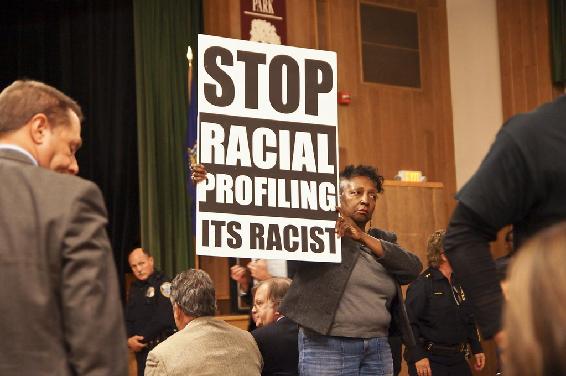6.4: Racial Profiling
- Page ID
- 16155
The challenge for police in multi-ethnic, liberal, democratic societies is to find the correct balance among the public goods at stake. They must enforce the law but also maintain racial and ethnic peace. These goals are incompatible to some extent. Enforcing the law may disrupt the peace. Keeping the peace may require forgoing opportunities to prevent crime or apprehend criminals.
The practice of racial profiling illustrates the tradeoff. In the past police defend the practice as an essential law enforcement tool needed to help identify potential drug couriers, terrorists, and other criminal types. More generally, they use race/ethnic appearance as one of several cues to suspect that something is amiss and that an investigation would be appropriate. A black male walking in an all-white neighborhood or in a deserted industrial park late at night, or driving an expensive new car, are common scenarios that traditionally have prompted police inquiries.
Such interventions undoubtedly prevent some crimes. But they also have high costs. They produce deep resentments and alienation among minorities who are repeatedly stopped and questioned by the police. They divide the community and undermine racial peace. Over time, they build up and explode in race riots or cheers from the black community for people like O.J. Simpson when they beat the system.
Law enforcement profiling is inappropriate when race or some other sociological factor, such as gender, sexual orientation, or religion is used as the sole criterion for taking law enforcement actions. Profiling that singles out members of the community for no reason other than their race is discriminatory and provides no legitimate basis for police action and has serious consequences. "Whether intentional or unintentional, the application of bias in policing tilts the scales of justice and results in unequal treatment under the law," writes Ronald L. Davis, the author of a study on bias-based policing for the National Organization of Black Law Enforcement Executives (NOBLE). Allegations of racial profiling and other bias-based policing activities, particularly traffic stops and random searches, have become national issues, as the escalating coverage in the media shows. There have also been legislative proposals at the state and national level addressing racial profiling, along with lawsuits brought by civil rights organizations and the U.S. Department of Justice.

Racial profiling erodes the necessary trust between law enforcement officials and the communities they serve. There is also the collateral damage of police recruitment of minorities being made more difficult and minorities becoming less willing to participate in the criminal justice process. The use of objective factors indicating potential criminal activity as a basis for making traffic stops may be a legitimate and effective law enforcement tool. However, inappropriate profiling impairs law enforcement's abilities. Furthermore, the use of race as the sole criterion for making traffic stops is legally and morally wrong. Discriminatory traffic stops divide communities and make police and prosecutors' jobs more difficult.
One way to address this issue is with a defined set of department values that are the basis of the department's policies, and practices. Law enforcement officials have to monitor and manage the discretion exercised by their officers to ensure their actions are guided by values and principles that gives preeminence to the civil rights of citizens. Racial profiling imposes on the basic freedoms granted in a democratic society. For many in the minority community, racial profiling is an old phenomenon with a new name. A common response to racial profiling is the development of policies that declare racial profiling illegal, limit officer discretion in the area of traffic stops, and mandate training in cultural diversity.
These measures are a necessary first step, but alone they cannot reduce bias in an organization. Symptoms will resurface and appear in other areas, such as walking stops, the use of force, police misconduct, minority officer recruitment, retention and promotion. Racial profiling is not the standalone problem; it is a symptom of bias-based policing.
Police departments and communities can avoid debilitating accusations of racial profiling by communicating with each other about police strategy, crime trends, and community concerns. In a response to the aftermath of the fatal shooting of Amadou Diallo by New York City police in 1999, George Kelling writes:
Police increasingly rely on analysis of crime data, mapping and other methods to develop tactics for addressing specific problems. When they discover that guns are the primary instruments of murder in black neighborhoods, is it racial profiling or smart policing to target anti-gun efforts there?”
Resolutions to these issues are possible, but not easy. They involve balancing individual rights with community interests, effectiveness with costs, and the tradeoffs among important values…Police and neighborhood leaders will have to seek each other out aggressively and honesty!

